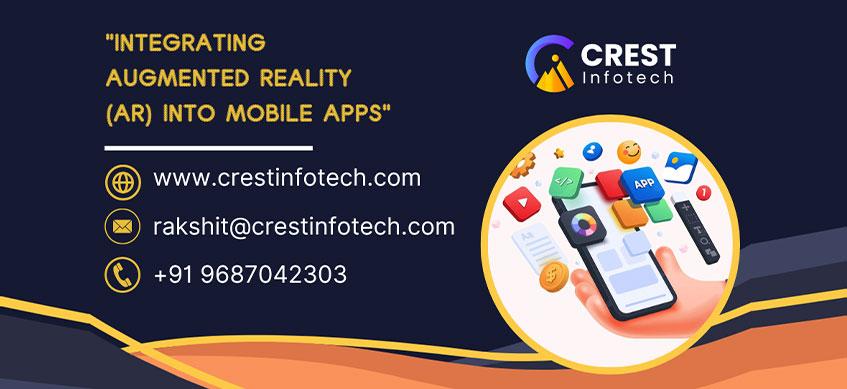Augmented Reality (AR) has revolutionized user interactions by blending digital elements with the physical world, offering immersive and interactive experiences through mobile devices. As AR technology continues to evolve, integrating AR into mobile apps presents exciting opportunities for businesses to engage users creatively, enhance product experiences, and differentiate their offerings in competitive markets. This article explores the benefits, applications, challenges, and best practices for successfully integrating AR into mobile apps.
Understanding Augmented Reality (AR)
Augmented Reality overlays digital content—such as 3D models, animations, or information—onto the user’s real-world environment, viewed through a smartphone or tablet camera. Key components of AR integration include:
- Marker-based AR: Uses physical markers or triggers (QR codes, images) to anchor digital content in the real world.
- Markerless AR: Tracks the device’s position and orientation to place virtual objects in the environment without markers.
- Depth Sensing: Utilizes sensors to map physical surroundings and enable realistic interactions between virtual and real objects.
Benefits of Integrating AR into Mobile Apps
- Enhanced User Engagement:
- Provides immersive, interactive experiences that captivate users and encourage longer app engagement sessions.
- Offers novel ways for users to interact with products, services, or information through real-time AR simulations or visualizations.
- Improved Product Visualization:
- Enables users to visualize products in their real-world environment before making purchase decisions (e.g., furniture placement, home decor, fashion items).
- Interactive Marketing and Branding:
- Facilitates interactive marketing campaigns, promotions, and branded AR experiences that engage users and enhance brand recall.
- Educational and Training Applications:
- Enhances learning experiences with AR-enabled educational content, simulations, and training modules across various industries (e.g., healthcare, engineering, education).
- Gamification and Entertainment:
- Integrates AR features into mobile games, entertainment apps, and social media platforms to create interactive gameplay and engaging user experiences.
Applications of AR in Mobile Apps
- Retail and E-Commerce:
- Enables virtual try-on for clothing, accessories, and cosmetics, allowing users to see how products look before purchase.
- Visualizes furniture, home decor, and appliances in users’ living spaces using AR-powered room mapping and sizing tools.
- Real Estate and Property Visualization:
- Provides virtual property tours, architectural visualizations, and interactive floor plans to prospective buyers and renters.
- Healthcare and Medical Training:
- Facilitates medical training simulations, patient education, and anatomical visualizations through AR-enhanced apps for healthcare professionals and patients.
- Travel and Tourism:
- Offers AR-guided tours, historical reconstructions, and interactive maps that enhance sightseeing experiences and provide contextual information.
- Gaming and Entertainment:
- Integrates AR features into mobile games, enhancing gameplay with interactive elements, augmented environments, and location-based challenges.
Best Practices for Implementing AR in Mobile Apps
- Understand User Needs and Use Cases:
- Identify specific user needs, preferences, and pain points that AR can address to deliver value-added experiences.
- Focus on Usability and User Experience (UX):
- Design intuitive AR interfaces and interactions that are easy to navigate, understand, and engage with for users of all ages and technical backgrounds.
- Optimize Performance and Stability:
- Prioritize AR performance optimization, including frame rate, rendering quality, and device compatibility, to ensure smooth and responsive user experiences.
- Ensure Data Privacy and Security:
- Implement robust data privacy measures and secure data handling practices to protect user information collected through AR interactions.
- Iterate Based on User Feedback:
- Gather user feedback, analytics, and usage metrics to iterate on AR features, improve functionality, and enhance user satisfaction over time.
Challenges in AR Integration
- Hardware Limitations: Varied device capabilities (e.g., camera quality, processing power) impact AR performance and user experience consistency.
- Content Creation Complexity: Developing high-quality AR content (e.g., 3D models, animations) requires specialized skills, tools, and resources.
- User Acceptance and Adoption: Educating users about AR capabilities, benefits, and usage scenarios may influence initial adoption and engagement rates.
- Integration with Existing Systems: Integrating AR functionalities seamlessly with existing app architectures, databases, and backend systems poses technical integration challenges.
Conclusion
Integrating Augmented Reality (AR) into mobile apps empowers businesses to deliver immersive, interactive, and personalized experiences that captivate users and drive engagement. By leveraging AR technology to enhance product visualization, educational content, gaming experiences, and real-world interactions, apps can differentiate themselves in competitive markets and meet evolving user expectations for innovative digital experiences. Implementing best practices, understanding user needs, optimizing performance, and addressing technical challenges are essential for successful AR integration that enhances user satisfaction, drives app adoption, and fosters long-term user loyalty.
As AR technology continues to evolve and expand, incorporating AR capabilities into mobile apps offers limitless possibilities for creativity, innovation, and enhancing user experiences across diverse industries and applications.
This article explores the transformative impact of integrating Augmented Reality (AR) into mobile apps, emphasizing benefits, applications, challenges, and best practices for leveraging AR technology to deliver immersive, interactive, and personalized user experiences. Adjust content based on specific industry trends, technological advancements, and user engagement strategies relevant to your app development and AR integration initiatives.



